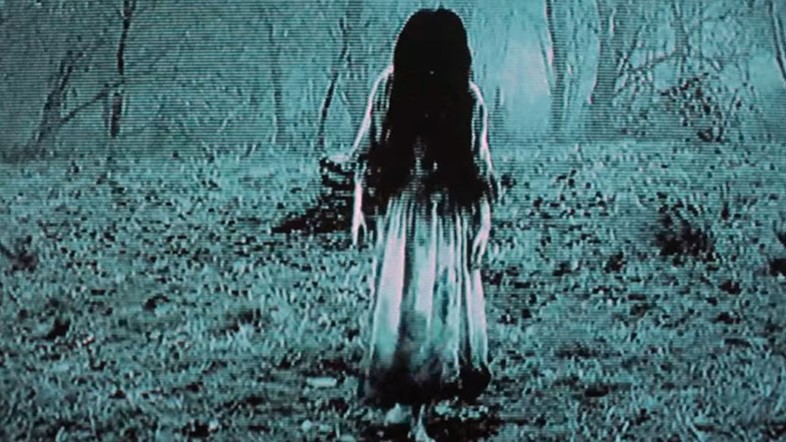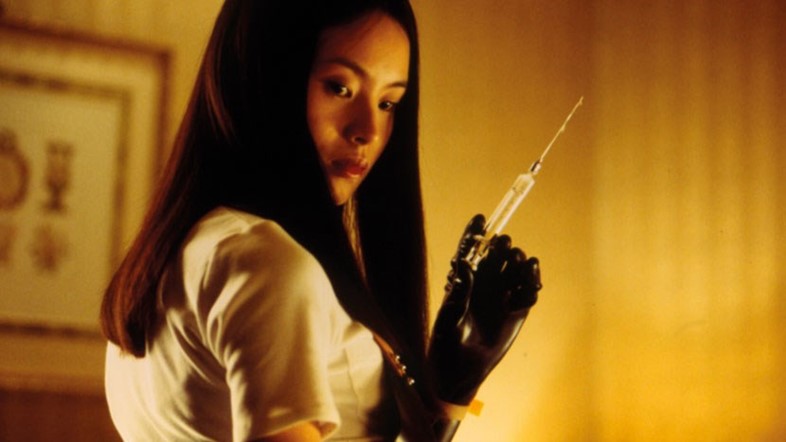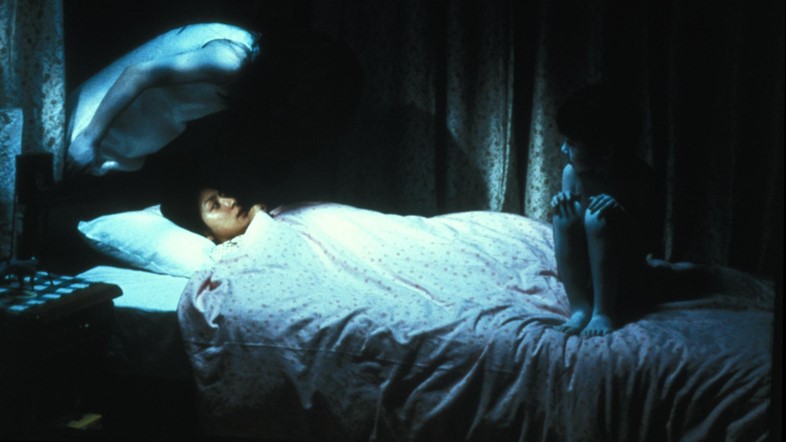Ghosts, gore and shadow spirits: James Balmont selects the unmissable films from Japan’s Y2K horror era
It was in the late 90s, in the aftermath of a triple-whammy of major film festival wins by directors Takeshi Kitano, Shōhei Imamura, and Naomi Kawase, that Japanese cinema experienced its last great sustained moment in the West. All it took was one long-haired ghost named Sadako and a cursed videotape for Japanese cinema to go international in a manner not seen since the 60s. In the wake of Hideo Nakata’s 1998 classic Ring, Japanese horror would leave a lasting legacy on Hollywood.
The movement, dubbed ‘J-Horror’, arrived in the UK on VHS and DVD via distribution labels like Tartan Video and Premier Asia. These brands capitalised on a gap the market fashioned by independent hits like The Blair Witch Project, which had driven attention away from Hollywood franchise features by fusing low budget innovation with psychological impression. By the mid-00s, these Japanese films were being remade in Hollywood and raking in millions of dollars in box office receipts, with Gore Verbinski’s $249.3m-grossing The Ring leading the pack.
In their original Japanese forms, these films possessed uniquely terrifying qualities that marked them out from the popular Hollywood slashers of the time, like The Faculty, Urban Legend, and Halloween: H20. Instead of serial killers and screaming teens, films like Ring and Ju-on: The Grudge harked back to the horror films of Japan’s cinematic “golden age” – Onibaba (Kaneto Shindô, 1964), Kwaidan (Masaki Kobayashi, 1965), and Kuroneko (Shindô, 1968) – which had themselves taken influence from Kabuki Theatre and Meiji-era folk tales about vengeful spirits and curses.
Infused with a techno-paranoia befitting of widespread Y2K anxieties (yes, the “Millennium bug” was a thing), these films blurred the terrifying present with Japan’s storied past, resulting in a series of restrained psychological terrors that relied heavily on the power of the imagination. As the trend boomed in the West, so too did an interest in the wider pantheon of Japanese low-budget filmmaking, including violent detractions from the J-Horror mould that would foreshadow the popularity of extreme horror films in the West. Before Saw, Wolf’s Creek, and The Devil’s Rejects, there was Takashi Miike’s Ichi The Killer, and Sion Sono’s Suicide Club.
As part of the BFI’s Halloween programming, six classic works from the wider J-Horror movement will hit the big screen at the BFI Southbank as the ‘J-Horror Weekender’, which is part of the ongoing Japan 2021 season. Additional works from the genre, meanwhile, can be streamed today via the BFI Player online. To mark these events (at the scariest time of the year), AnOther selects five key films below that typify this last great and terrifying boom of Japanese cinema in the West.

Ring, 1998
In this age of digital streaming, social media and ubiquitous access to information, it can be hard to truly comprehend the psychological impact that a film like Ring had on viewers in the late 90s. It was the film that kick-started the entire J-horror explosion, leading to franchises, Hollywood remakes and widespread consumption of Asian cinema not seen again until Parasite hit screens in 2019.
Ring is slow, atmospheric and positively dread-inducing. A female journalist named Reiko investigates a string of unexplained deaths and is led to an isolated holiday cabin in the wooded countryside, where she discovers a strange videotape full of cryptic, distorted images. The tape lingers on a stone well in a clearing at the climax, and immediately afterwards she receives a phone call informing her that she will die in seven days. Reiko must solve the mystery of the cursed tape in order to avoid the same fate as the victims she’s investigating.
Just like the equally terrifying The Blair Witch Project – a faux-documentary horror that was released only a year later – Ring got right into the heads of its viewers by convincing them that they were not simply watching fiction, but something far more dangerous. With VHS tape still the most popular mode of visual media consumption at the turn of century, Ring effectively transcended the very format it existed on, placing the object of terror right inside people’s living rooms.
Themes of techno-paranoia and images of long-haired ghosts would become hallmarks of the J-horror movement thereafter – but few outings were as memorable or impactful as this.

Audition, 1999
Audition was the film responsible for introducing the prolific and provocative director Takashi Miike to Western audiences, and the BFI recognise his influence by screening this cult classic alongside Miike’s similarly audacious yakuza drama Ichi The Killer on Halloween. Both films are outliers in the J-Horror programming, eschewing psychological horror in favour of visual repulsion via torture and extreme violence.
But the opening half of Audition unfolds as a slow, dull romantic drama about a widower named Aoyama trying to find a new wife – a preface to one of the greatest switcheroos in horror cinema history. Asami, the demure and polite woman Aoyama eventually falls for, is no more exciting than the grey-washed colour scheme and still camera shots that mark much of the film’s first two acts. But the rug is eventually pulled out from under the viewer (and Aoyama) in a fashion that remains shocking to this day, accompanied by the repeated utterance of the phrase “kiri kiri kiri kiri”.
Critics remain divided over whether the film – adapted from a novel by Ryu Murakami (Coin Locker Babies; In The Miso Soup) – is an empowering tale of feminist retribution, or misogynistic by its very nature. But whether she’s an anti-hero or a victim, Asami’s presence in the canon of horror icons is indisputable to this day.

Dark Water, 2002
The second of two Nakata films screening at the BFI this weekend was also remade in Hollywood – though the diminished returns of Walter Salles’ 2005 Jennifer Connelly vehicle would point towards the genre’s wider decline in the West. That’s no blemish on the Japanese original, though. Dark Water was Nakata’s second adaption of a work written by Koji Suzuki, the man responsible for the Ring novels that inspired Nakata’s previous hit. The partnership would prove a winning combo once again.
Dark Water follows a lonely young mother, Yoshimi, stuck in the middle of a messy divorce arrangement. Forced to rent a room in an old housing complex, she and her young daughter soon find themselves plagued by rain, damp stains and unexplained water spillages in their apartment. A red schoolbag, meanwhile, keeps appearing around the building, leading Yoshimi to the building’s roof, where an old water tower stands imposingly. Elsewhere, Yoshimi is troubled by a notice for a missing child who had disappeared a year prior, who looks remarkably similar to her own daughter.
With looming corridors, a washed-out colour palette and evocative use of lighting, Dark Water builds a creepy atmosphere inside a powerful and memorable setting (with a few throwbacks to The Shining for good measure). But even more unnerving are the parallels with a tragic true crime case that occurred several years later. The film’s use of unsettling elevator CCTV footage, and the significance of a water tower on the rooftop, would mirror the circumstances surrounding the disappearance of a 21-year-old Canadian student named Elisa Lam in 2013. The disturbing event was explored in a four-part Netflix documentary series in 2021, titled Crime Scene: The Vanishing at the Cecil Hotel.

Ju-on: The Grudge, 2002
Searching for the origins of The Grudge series can feel like something of a nightmare in itself. While the 2004 US remake starring Sarah Michelle Gellar remains the most recognisable in the West (it grossed $187.2m upon release), the franchise was, in fact, already several films deep by that point in Japan, with two TV shorts and another two direct-to-video anthologies preceding a duo of cinematic sequel-remakes. What’s even more disorientating is that they’re all titled near-identically. And they’re all written and directed by the same man – including the Hollywood version.
It is the third entry of the series – the first to be produced for the big screen – that is probably director Takashi Shimizu’s best-executed version of his foreboding ghost story. Fittingly (and unlike his own American adaption), the narrative itself is broken up into a string of non-linear short stories, which makes things somewhat confusing at first. But before long, the paint-white ghosts, croaking shadow spirits and screeching black cats that centre around a haunted house in Tokyo provide an effective connective tissue that string tales of cursed tenants and missing schoolchildren together.
Shimizu’s knack for a good ghost story was nurtured by one of the best in the game. The director was the student of J-Horror master Kiyoshi Kurosawa at the Film School of Tokyo in the 90s. It was Kurosawa’s recommendation of Shimizu to Kansai Telecasting Corporation that landed the emerging director his first work, on a journey that would take him from video to cinema, to Hollywood.

Retribution, 2006
On the second day of their J-Horror Weekender, the BFI screen Cure and Pulse – two bonafide classics from Kiyoshi Kurosawa, explored previously by AnOther. Less widely renowned is the 2006 film Retribution, which was completed at the tail end of J-Horror’s commercial popularity. While its plot is convoluted, the film is as captivating and atmospheric as anything the director had delivered prior.
An eerie mystery that takes cues from the director’s previous masterpieces, Retribution stars Kōji Yakusho in a role that’s remarkably similar to that which he had played in Cure. He’s a grizzled detective investigating a series of murders by drowning, all of which take place near a riverside – but where the victims are found to have inhaled saltwater. The bodies begin to pile up, but despite a suspect’s confession, the evidence increasingly points towards Yakusho. At the same time, he becomes troubled by a grudge-bearing apparition who wears a red dress. As the case gets increasingly bizarre, he finds himself haunted by a fractured memory from his youth.
The film was initially green-lit as part of the J-Horror Theatre project: an anthology series intended to capitalise on the global success of Japanese horror cinema, spearheaded by producer Takashige Ichise (whose credits include both the Japanese and US versions of Ring, Dark Water and The Grudge). While the series acts as a springboard towards further examples of the genre, with titles like Reincarnation, Premonition and Infection, Kurosawa’s offering transcended the group. It premiered at Venice in 2006 – the same festival where he’d be awarded the Silver Lion for Best Director 14 years later, for the 2020 film Wife of a Spy.
